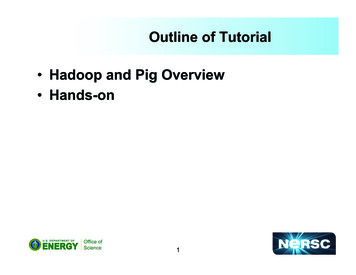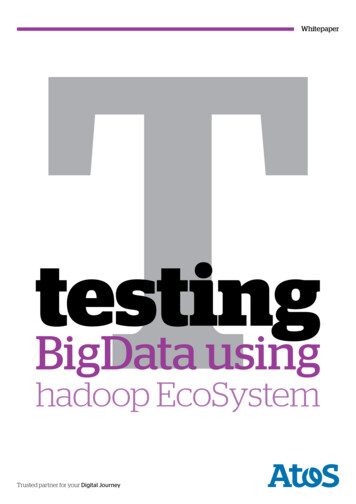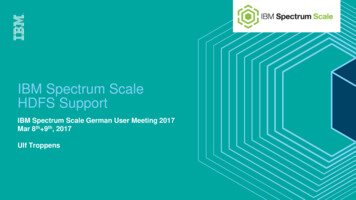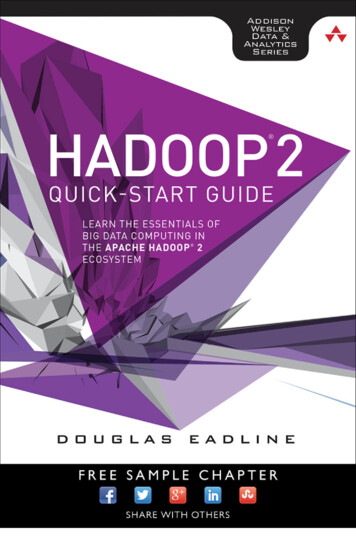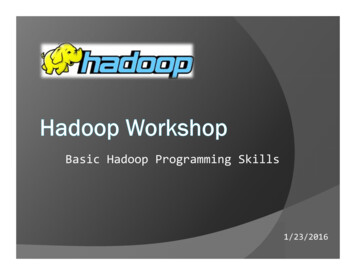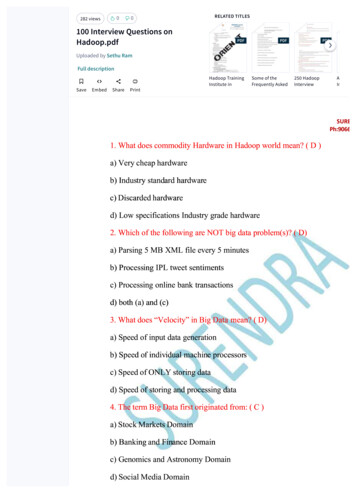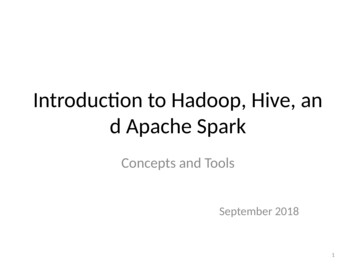
Transcription
Hadoop Learning Resources1Hadoop Certification(Developer, AdministratorHBase & Data Science)CCD-410, CCA-410 andCCB-400 and DS-200Author: Hadoop Learning ResourceHadoop Training in Just 60/3000INRVisit www.HadoopExam.com for DetailsInterview Questions Start from Page 7
Hadoop Learning Resources2Hadoop Interview Questions on Page 7Hadoop Certification Exam Simulator Study MaterialoContains 4 practice Question Papero240 realistic Hadoop Developer CertificationQuestionso238 realistic Hadoop Administrator CertificationQuestionso 225 realistic HBase Certification QuestionsoAll Questions are on latest PatternoEnd time 15 Page revision notes (Save lot of time)oDownload from www.HadoopExam.comNote: There is 50% talent gap in BigData domain, get Hadoop certification with theHadoop Learning Resources Hadoop Exam Simulator.
Hadoop Learning Resources3Best Quality Hadoop Training is in Just 60/3000INR(Guarantee you love it.the way trainer is teaching. just watch sample two modules.)First two modules are free (Best Quality is Promise, watch it right now) Best Hadoop Training Quality Guaranteed amongall Vendors. Believe in us you will saywow.it’s Great. after watching first two modulesModule 1 : Introduction to BigData, Hadoop (HDFS and MapReduce) : Available (Length 35 Minutes)1. BigData Inroduction2. Hadoop Introduction3. HDFS Introduction4. MapReduce IntroductionVideo URL : http://www.youtube.com/watch?v R-qjyEn3bjsModule 2 : Deep Dive in HDFS : Available (Length 48 Minutes)1. HDFS Design2. Fundamental of HDFS (Blocks, NameNode, DataNode, Secondary Name Node)3. Rack Awareness4. Read/Write from HDFS5. HDFS Federation and High Availability6. Parallel Copying using DistCp7. HDFS Command Line InterfaceVideo URL : http://www.youtube.com/watch?v PK6Im7tBWowModule 3 : Understanding MapReduce : Available (Length 60 Minutes)1. JobTracker and TaskTracker2. Topology Hadoop cluster3. Example of MapReduceMap FunctionReduce Function4. Java Implementation of MapReduce5. DataFlow of MapReduce6. Use of CombinerVideo URL : Watch Private VideoModule 4 : MapReduce Internals -1 (In Detail) : Available (Length 57 Minutes)1. How MapReduce Works2. Anatomy of MapReduce Job (MR-1)3. Submission & Initialization of MapReduce Job (What Happen ?)4. Assigning & Execution of Tasks5. Monitoring & Progress of MapReduce Job6. Completion of Job
Hadoop Learning Resources7. Handling of MapReduce Job- Task Failure- TaskTracker Failure- JobTracker FailureVideo URL : Watch Private VideoModule 5 : MapReduce-2 (YARN : Yet Another Resource Negotiator) : Available (Length 52 Minutes)1. Limitation of Current Architecture (Classic)2. What are the Requirement ?3. YARN Architecture4. JobSubmission and Job Initialization5. Task Assignment and Task Execution6. Progress and Monitoring of the Job7. Failure Handling in YARN- Task Failure- Application Master Failure- Node Manager Failure- Resource Manager FailureVideo URL : Watch Private VideoModule 6 : Advanced Topic for MapReduce (Performance and Optimization) : Available (Length 58 Minutes)1. Job Sceduling2. In Depth Shuffle and Sorting3. Speculative Execution4. Output Committers5. JVM Reuse in MR16. Configuration and Performance TuningVideo URL : Watch Private VideoModule 7 : Advanced MapReduce Algorithm : Available (Length 87 Minutes)File Based Data Structure- Sequence File- MapFileDefault Sorting In MapReduce- Data Filtering (Map-only jobs)- Partial SortingData Lookup Stratgies- In MapFilesSorting Algorithm- Total Sort (Globally Sorted Data)- InputSampler- Secondary SortVideo URL : Watch Private VideoModule 8 : Advanced MapReduce Algorithm -2 : Available : Private (Length 67 Minutes)4
Hadoop Learning Resources1. MapReduce Joining- Reduce Side Join- MapSide Join- Semi Join2. MapReduce Job Chaining- MapReduce Sequence Chaining- MapReduce Complex ChainingVideo URL : Watch Private VideoModule 9 : Features of MapReduce : Available : Private (Length 61 Minutes)Introduction to MapReduce CountersTypes of CountersTask CountersJob CountersUser Defined CountersPropagation of CountersSide Data DistributionUsing JobConfigurationDistributed CacheSteps to Read and Delete Cache FileVideo URL : Watch Private VideoModule 10: MapReduce DataTypes and Formats : Available : Private (Length 77 Minutes)1.Serialization In Hadoop2. Hadoop Writable and Comparable3. Hadoop RawComparator and Custom Writable4. MapReduce Types and Formats5. Understand Difference Between Block and InputSplit6. Role of RecordReader7. FileInputFormat8. ComineFileInputFormat and Processing whole file Single Mapper9. Each input File as a record10. Text/KeyValue/NLine InputFormat11. BinaryInput processing12. MultipleInputs Format13. DatabaseInput and Output14. Text/Biinary/Multiple/Lazy OutputFormat MapReduce TypesVideo URL : Watch Private VideoModule 11 : Apache Pig : Available (Length 52 Minutes)1. What is Pig ?2. Introduction to Pig Data Flow Engine3. Pig and MapReduce in Detail4. When should Pig Used ?5. Pig and Hadoop Cluster6. Pig Interpreter and MapReduce5
Hadoop Learning Resources67. Pig Relations and Data Types8. PigLatin Example in Detail9. Debugging and Generating Example in Apache PigVideo URL : Watch Private VideoModule 12 : Fundamental of Apache Hive Part-1 : Available (Length 60 Minutes)1. What is Hive ?2. Architecture of Hive3. Hive Services4. Hive Clients5. how Hive Differs from Traditional RDBMS6. Introduction to HiveQL7. Data Types and File Formats in Hive8. File Encoding9. Common problems while working with HiveVideo URL : Watch Private VideoModule 13 : Apache Hive : Available (Length 73 Minutes )1. HiveQL2. Managed and External Tables3. Understand Storage Formats4. Querying Data- Sorting and Aggregation- MapReduce In Query- Joins, SubQueries and Views5. Writing User Defined Functions (UDFs)3. Data types and schemas4. Querying Data5. HiveODBC6. User-Defined FunctionsVideo URL : Watch Private VideoModule 14 : Hands On : Single Node Hadoop Cluster Set Up In Amazon Cloud : Available (Length 60 Minutes HandsOn Practice Session)1. How to create instance on Amazon EC22. How to connect that Instance Using putty3. Installing Hadoop framework on this instance4. Run sample wordcount example which come with Hadoop framework.In 30 minutes you can create Hadoop Single Node Cluster in Amazon cloud, does it interest you ?Video URL : Watch Private VideoModule 15 : Hands On : Implementation of NGram algorithm : Available (Length 48 Minutes Hands On PracticeSession)1. Understand the NGram concept using (Google Books NGram )2. Step by Step Process creating and Configuring eclipse for writing MapReduce Code3. Deploying the NGram application in Hadoop Installed in Amazon EC24. Analyzing the Result by Running NGram application (UniGram, BiGram, TriGram etc.)
Hadoop Learning Resources7Video URL : Watch Private VideoModule 16 : Hands On : Hadoop MultiNode Cluster Setup and Running a BigData Example : Available (Length 70Minutes)1. Hadoop MultiNode Cluster2. Setup Three Node Hadoop cluster3. Running NGram Application on cluster4. Analyze the cluster using-- NameNode UI (Multiple Blocks and effect of Replication Factor)-- JobTracker UI (Multiple MapTask running on different Nodes)5. SettingUp Replication FactorVideo URL : Watch Private VideoHadoop Interview Questions1. What is Hadoop framework?Ans: Hadoop is a open source framework which is written in java by apchesoftware foundation. This framework is used to wirite software application whichrequires to process vast amount of data (It could handle multi tera bytes of data).It works in-paralle on large clusters which could have 1000 of computers (Nodes)on the clusters. It also process data very reliably and fault-tolerant manner. Seethe below image how does it looks.2. On What concept the Hadoop framework works?Ans : It works on MapReduce, and it is devised by the Google.3. What is MapReduce ? Ans: Map reduce is an algorithm or concept to process Huge amount of data in afaster way. As per its name you can divide it Map and Reduce.The main MapReduce job usually splits the input data-set into independent chunks.(Big data sets in the multiple small datasets)
Hadoop Learning Resources MapTask: will process these chunks in a completely parallel manner (One node canprocess one or more chunks).8
Hadoop Learning Resources The framework sorts the outputs of the maps. Reduce Task : And the above output will be the input for the reducetasks, producesthe final result.Your business logic would be written in the MappedTask and ReducedTask.Typically both the input and the output of the job are stored in a file-system (Notdatabase). The framework takes care of scheduling tasks, monitoring them andre-executes the failed tasks.4. What is compute and Storage nodes?Ans:Compute Node: This is the computer or machine where your actual businesslogic will be executed.Storage Node: This is the computer or machine where your file system reside tostore the processing data.In most of the cases compute node and storage node would be the samemachine.5. How does master slave architecture in the Hadoop?Ans: The MapReduce framework consists of a single master JobTracker andmultiple slaves, each cluster-node will have one TaskskTracker.The master is responsible for scheduling the jobs' component tasks on theslaves, monitoring them and re-executing the failed tasks. The slaves execute thetasks as directed by the master.6. How does an Hadoop application look like or their basic components?Ans: Minimally an Hadoop application would have following components. Input location of data Output location of processed data. A map task. A reduced task. Job configurationThe Hadoop job client then submits the job (jar/executable etc.) and configurationto the JobTracker which then assumes the responsibility of distributing thesoftware/configuration to the slaves, scheduling tasks and monitoring them,providing status and diagnostic information to the job-client.7. Explain how input and output data format of the Hadoop framework?9
Hadoop Learning ResourcesAns: The MapReduce framework operates exclusively on pairs, that is, theframework views the input to the job as a set of pairs and produces a set of pairsas the output of the job, conceivably of different types. See the flow mentioned below(input) - map - - combine/sorting - - reduce - (output)8. What are the restriction to the key and value class ?Ans: The key and value classes have to be serialized by the framework. To make themserializable Hadoop provides a Writable interface. As you know from the java itself thatthe key of the Map should be comparable, hence the key has to implement one moreinterface WritableComparable.9. Explain the WordCount implementation via Hadoop framework ?Ans: We will count the words in all the input file flow as below inputAssume there are two files each having a sentenceHello World Hello World (In file 1)Hello World Hello World (In file 2) Mapper : There would be each mapper for the a fileFor the given sample input the first map output: Hello, 1 World, 1 Hello, 1 World, 1 The second map output: Hello, 1 World, 1 Hello, 1 World, 1 Combiner/Sorting (This is done for each individual map)So output looks like thisThe output of the first map: Hello, 2 World, 2 The output of the second map: Hello, 2 World, 2 Reducer :It sums up the above output and generates the output as below Hello, 4 World, 4 Output10
Hadoop Learning ResourcesFinal output would look likeHello 4 timesWorld 4 times10. Which interface needs to be implemented to create Mapper and Reducerfor the pache.hadoop.mapreduce.Reducer11
Hadoop Learning Resources12Hadoop Certification Exam Simulator Study MaterialoContains 4 practice Question Papero240 realistic Hadoop Certification QuestionsoAll Questions are on latest PatternoEnd time 30 Page revision notes (Save lot of time)oDownload from www.HadoopExam.comNote: There is 50% talent gap in BigData domain, get Hadoop certification with theHadoop Learning Resources Hadoop Exam Simulator.11. What Mapper does?Ans: Maps are the individual tasks that transform input records into intermediate records. The transformed intermediate records do not needto be of the same type as the input records. A given input pair may map to zero or manyoutput pairs.12. What is the InputSplit in map reduce software?
Hadoop Learning ResourcesAns: An InputSplit is a logical representation of a unit (A chunk) of input work for amap task; e.g., a filename and a byte range within that file to process or a row set in a textfile.13. What is the InputFormat ?Ans: The InputFormat is responsible for enumerate (itemise) the InputSplits, andproducing a RecordReader which will turn those logical work units into actual physicalinput records.14. Where do you specify the Mapper Implementation?Ans: Generally mapper implementation is specified in the Job itself.15. How Mapper is instantiated in a running job?13
Hadoop Learning ResourcesAns: The Mapper itself is instantiated in the running job, and will be passed aMapContext object which it can use to configure itself.16. Which are the methods in the Mapper interface?Ans : The Mapper contains the run() method, which call its own setup() methodonly once, it also call a map() method for each input and finally calls it cleanup()method. All above methods you can override in your code.17. What happens if you don’t override the Mapper methods and keep them asit is?Ans: If you do not override any methods (leaving even map as-is), it will act asthe identity function, emitting each input record as a separate output.18. What is the use of Context object?Ans: The Context object allows the mapper to interact with the rest of the Hadoopsystem. ItIncludes configuration data for the job, as well as interfaces which allow it to emitoutput.19. How can you add the arbitrary key-value pairs in your mapper?Ans: You can set arbitrary (key, value) pairs of c
Hadoop Interview Questions 1. What is Hadoop framework? Ans: Hadoop is a open source framework which is written in java by apche software foundation. This framework is used to wirite software application which requires to process vast amount of data (It could handle multi tera bytes of data).File Size: 761KBPage Count: 25

